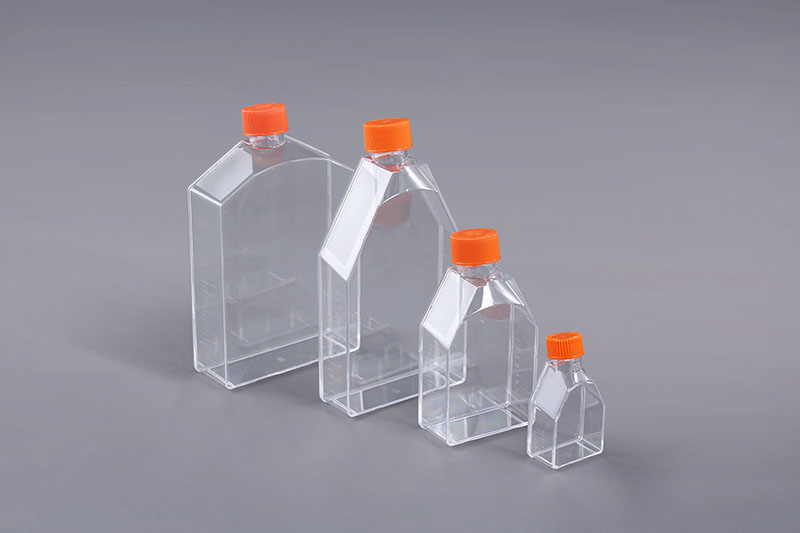je bežný spotrebný materiál pre bunkové kultúry, ktorý možno použiť na kultiváciu adherentných buniek a na kultiváciu suspenzných buniek. Medzi jeho mnohými aplikáciami tvoria relatívne veľkú kategóriu nádorové bunky. Nádorové bunky zaujímajú centrálnu pozíciu v tkanivovej kultúre. Po prvé, rakovinové bunky sa relatívne ľahko kultivujú. V súčasných zavedených bunkových líniách je veľa rakovinových bunkových línií. Nádory sú navyše pre človeka najhrozivejším ochorením. Kultivácia nádorových buniek je mimoriadne dôležitá metóda na štúdium mechanizmu rakoviny, detekcie protirakovinových liekov a molekulárnej biológie rakoviny. Bude hrať neoceniteľnú úlohu pri objasňovaní a riešení rakoviny.Je potrebné poznamenať, že pri použití Kultivácia nádorových buniek prostredníctvom kultivačných baniek je pre vedecké výskumné inštitúcie a farmaceutické spoločnosti dôležitým spôsobom, ako vykonávať výskum liekov a liečbu chorôb. Kľúč k úspechu spočíva vo výbere materiálov, eliminácii fibroblastov a výbere vhodných kultivačných médií a kultivačných substrátov. Pokiaľ ide o špecifické kultivačné metódy, neexistuje žiadny zásadný rozdiel medzi kultúrou nádorových buniek a kultúrou buniek normálneho tkaniva. Primárna kultúra môže využívať metódy kultivácie tkanivového bloku a trávenia.
na kultiváciu nádorových buniek fibroblasty často rastú zmiešané s nádorovými bunkami v rovnakom čase, čo sťažuje purifikáciu nádorových buniek a ovplyvní alebo dokonca potlačí rast nádorových buniek. Fibroblasty možno eliminovať mechanickým zoškrabaním, opakovaným prichytávaním, trávením a vylúčením a trávením kolagénu trypsínom. Konkrétny výber závisí od typu bunky. Bunkové kultivačné banky
Tumor cell culture through cell culture flasks is an important way for scientific research institutions and pharmaceutical companies to conduct drug research and disease treatment. The key to its success lies in the selection of materials, the elimination of fibroblasts, and the selection of appropriate culture media and culture substrates. In terms of specific culture methods, there is no principle difference between tumor cell culture and normal tissue cell culture. Primary culture can use tissue block and digestion culture methods.
It should be noted that when using cell culture flasks for tumor cell culture, fibroblasts often grow mixed with tumor cells at the same time, making it difficult to purify tumor cells, and it will affect or even suppress the growth of tumor cells. Fibroblasts can be eliminated by mechanical scraping, repeated attachment, digestion and exclusion, and collagen trypsin digestion. The specific choice depends on the type of cell.
The FAI climbed 5.9 percent year-on-year in the first 11 months of 2018, quickening from the 5.7-percent growth in Jan-Oct, the National Bureau of Statistics (NBS) said Friday in an online statement.
The key indicator of investment, dubbed a major growth driver, hit the bottom in August and has since started to rebound steadily.
In the face of emerging economic challenges home and abroad, China has stepped up efforts to stabilize investment, in particular rolling out measures to motivate private investors and channel funds into infrastructure.
Friday's data showed private investment, accounting for more than 60 percent of the total FAI, expanded by a brisk 8.7 percent.
NBS spokesperson Mao Shengyong said funds into weak economic links registered rapid increases as investment in environmental protection and agriculture jumped 42 percent and 12.5 percent respectively, much faster than the average.
In breakdown, investment in high-tech and equipment manufacturing remained vigorous with 16.1-percent and 11.6-percent increases respectively in the first 11 months. Infrastructure investment gained 3.7 percent, staying flat. Investment in property development rose 9.7 percent, also unchanged.
 English
English



















































